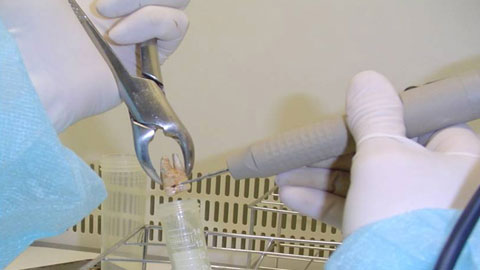Ancient genetic material from caries bacterium obtained for the first time

23/07/2014
This is highlighted in a study by researchers from the UAB and the Laboratorio Nacional de Genómica para la Biodiversidad (National Laboratory of Genomics for Biodiversity) in Mexico who, for the first time, have sequenced genetic material from this bacterium in populations from the past. Increase in genetic diversity has been produced especially in the fragment of a gene that codifies a virulence factor known as dextranase.
The research, published in Proceedings of The Royal Society B, has studied the bacterium in eleven individuals from the Bronze Age up to the twentieth century, in Europe and in both pre- and post-colonial America. The oldest case is that of an individual dating from 1200 BC, from the burial cave in Montanisell (Lleida, Catalonia); the most recent, from the UAB collection, dates from the beginning of the twentieth century.
“The relationship is well known between the increase in frequency of caries and the dietary changes that occurred in the Neolithic, or with the European discovery of America, with the large-scale introduction of sugarcane to Europe, or the Industrial Revolution, but what was not known was whether this change happened jointly with changes at a genetic level is this bacterium”, explains Marc Simón, trainee researcher in the UAB Biodiversity doctorate and the article’s principal author.
“We saw that, in the most recent populations, genetic diversity was greater; to us, this indicates a population-based expansion by the bacterium that may have occurred in parallel with the demographic expansion of humans. We think that this increase took place in the Neolithic. Currently, the oldest individual we have analysed is from the Bronze Age, but we might actually be witnessing the continuation of this process. In the future, we hope to be able to work with even older samples in order to corroborate our hypothesis”.
The study opens up the possibility of providing evidence for the historical relationship between caries and human beings as well as ascertaining the ways in which distinct historical moments may have affected this; additionally, it makes it possible to reconstruct the dietary habits of the ancient population or of the population movements that took place.
For Assumpció Malgosa, researcher in Biological Anthropology at the UAB and coordinator of this research, “it is important to know how the gene varied in the past in order to predict models of evolution for caries virulence, to know whether these changes were a response brought about in order to adapt better to changing environments or even to other parts of the human body, such as the gastrointestinal tract, or if they changed to become resistant when conditions of hygiene improved, etc. Knowing how they reacted in the past in different situations can provide us with an idea of how they will do so in the future in similar circumstances”.
The study was carried out in the UAB Physical Anthropology laboratory, with some of the samples being replicated in the Laboratorio Nacional para la Biodiversidad in Mexico. The project was financed by the Spanish Ministry of Education and Science, the Catalan Government (Generalitat de Catalunya) and the Mexican National Council for Science and Technology (CONACYT).
Reference to the article: Simón M, Montiel R, Smerling A, Solórzano E, Díaz N, Álvarez, Sandoval BA, Jiménez-Marín AR, Malgosa A. 2014. “Molecular analysis of ancient caries”. Proc. R. Soc. B 20140586. http://dx.doi.org/10.1098/rspb.2014.0586
Images:
http://www.uab.cat/uabdivulga/img/UAB-BacteriCaries1.jpg
Image of ancient DNA laboratory work during sample collection/UAB
http://www.uab.cat/uabdivulga/img/UAB-BacteriCaries2.jpg
Caries affecting the first lower-right molar, which has also completely destroyed the neighbouring tooth/UAB